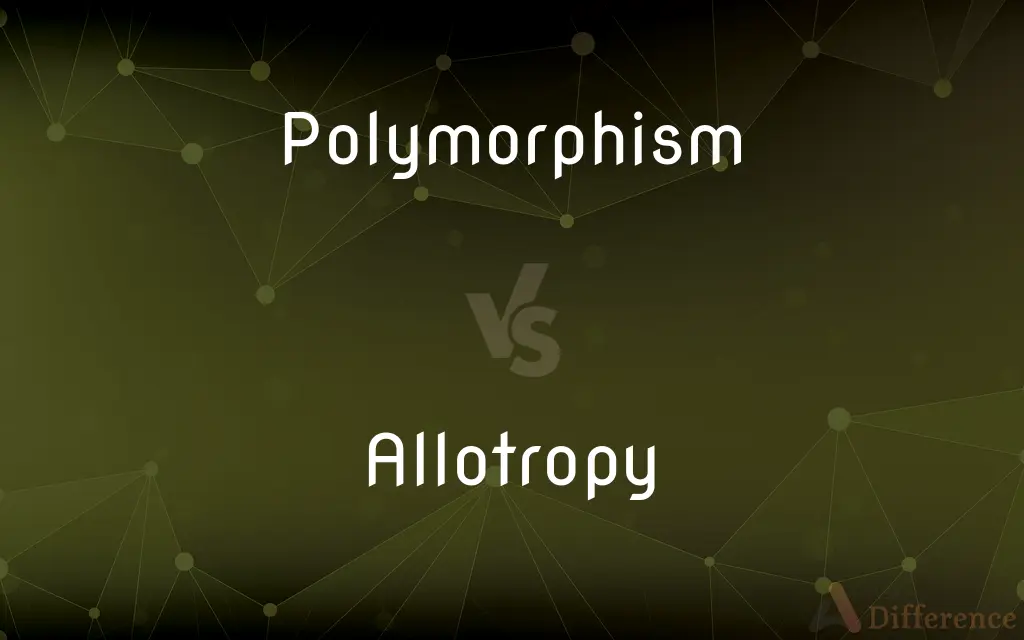Polymorphism vs. Allotropy — What's the Difference?
Edited by Tayyaba Rehman — By Maham Liaqat — Updated on March 20, 2024
Polymorphism refers to the ability of a substance to exist in multiple forms, while allotropy specifically describes this phenomenon in elements.

Difference Between Polymorphism and Allotropy
Table of Contents
ADVERTISEMENT
Key Differences
Polymorphism is a term used in various scientific disciplines, including chemistry and biology, to describe the ability of a substance to exist in two or more different forms, known as polymorphs. These forms can differ in structure and often in physical properties, such as melting point, while remaining the same chemically. Whereas, allotropy is a form of polymorphism that applies specifically to elements, describing the existence of two or more different forms of the same element in the same physical state.
In polymorphism, the different forms arise due to the arrangement of molecules or ions in the solid state, affecting the substance's physical properties without altering its chemical composition. This phenomenon is observed in many compounds, including pharmaceuticals, where it can significantly impact the drug's efficacy and stability. On the other hand, allotropy involves only elements, such as carbon existing as diamond, graphite, and graphene. These allotropes have distinct structures and properties but consist entirely of carbon atoms.
Polymorphism can occur in any chemical substance, including compounds and mixtures, and is crucial for materials science, geology, and pharmaceuticals, affecting the material's properties and applications. Conversely, allotropy is limited to chemical elements and plays a significant role in understanding elemental behavior and developing materials with specific properties, like the strength of diamond or the electrical conductivity of graphite.
While polymorphism emphasizes the diversity of forms a substance can take, highlighting the versatility and complexity of chemical substances, allotropy focuses on the unique capability of elements to exist in forms with drastically different physical and chemical properties. This distinction underlines the broader scope of polymorphism, encompassing a wide range of substances beyond just elements.
Both polymorphism and allotropy have significant implications in various fields, from materials science to pharmaceuticals, influencing how substances are studied, utilized, and manufactured. However, allotropy specifically provides insight into the versatile nature of elements, offering opportunities to explore and harness their varied properties for innovative applications.
ADVERTISEMENT
Comparison Chart
Definition
Ability of a substance to exist in multiple forms
Polymorphism in elements
Applies To
Compounds, mixtures, and elements
Only elements
Examples
Pharmaceuticals, minerals
Carbon (diamond, graphite), Oxygen (O2, O3)
Impact on Properties
Can significantly change physical properties
Results in different physical and chemical properties
Relevance
Materials science, geology, pharmaceuticals
Materials science, chemistry
Compare with Definitions
Polymorphism
Can occur due to differences in temperature, pressure, or crystallization conditions.
Silica shows polymorphism, existing in various forms like quartz and cristobalite.
Allotropy
Key in the field of chemistry and materials science for understanding element behavior.
Studying allotropy helps in discovering new materials with novel properties.
Polymorphism
Crucial in pharmaceuticals as it affects drug solubility and absorption.
The polymorphic form of a drug can significantly influence its effectiveness.
Allotropy
Enables the use of elements in diverse applications due to varying properties of allotropes.
Graphene, an allotrope of carbon, is used in high-strength materials and electronics due to its exceptional properties.
Polymorphism
The existence of a substance in more than one form or crystal structure.
Calcium carbonate exists as calcite and aragonite, displaying polymorphism.
Allotropy
Fundamental in developing materials with specific characteristics, such as superconductors.
The allotropes of carbon are used in various applications, from electronics to jewelry.
Polymorphism
Affects the physical properties of materials, including melting point and hardness.
The polymorphic forms of a compound may have distinct melting points, affecting its use in formulations.
Allotropy
The property of some chemical elements to exist in two or more different forms, in the same physical state.
Carbon exhibits allotropy, appearing as diamond, graphite, and graphene.
Polymorphism
Analyzed in materials science to develop materials with desired properties.
Polymorphism is studied to improve the manufacturing process of polymers.
Allotropy
Result of different bonding arrangements between atoms of the same element.
Oxygen exists as both O2 and ozone (O3), showcasing its allotropy.
Polymorphism
(Biology) The occurrence of more than one form, as several alleles of a particular gene or winged and wingless forms of the same species.
Allotropy
Allotropy or allotropism (from Ancient Greek ἄλλος (allos) 'other', and τρόπος (tropos) 'manner, form') is the property of some chemical elements to exist in two or more different forms, in the same physical state, known as allotropes of the elements. Allotropes are different structural modifications of an element; the atoms of the element are bonded together in a different manner.
Polymorphism
(Chemistry) Crystallization of a compound in at least two distinct forms. Also called pleomorphism.
Allotropy
The existence of two or more crystalline or molecular structural forms of an element that have different chemical or physical attributes.
Polymorphism
The ability to assume different forms or shapes.
Allotropy
(chemistry) A property, exhibited by some elements, of existing in multiple forms with different atomic structures.
Polymorphism
(object-oriented programming) The feature pertaining to the dynamic treatment of data elements based on their type, allowing for an instance of a method to have several definitions. en
Allotropy
The phenomenon of an element existing in two or more physical forms
Polymorphism
The property of certain typed formal systems of allowing for the use of type variables and binders/quantifiers over those type variables; likewise, the property of certain expressions (within such typed formal systems) of making use of at least one such typed variable.
Polymorphism
(crystallography) The ability of a solid material to exist in more than one form or crystal structure; pleomorphism.
Polymorphism
(genetics) The regular existence of two or more different genotypes within a given species or population; also, variability of amino acid sequences within a gene's protein.
Polymorphism
Same as Pleomorphism.
Polymorphism
The capability of assuming different forms; the capability of widely varying in form.
Polymorphism
(chemistry) the existence of different kinds of crystal of the same chemical compound
Common Curiosities
Why is polymorphism important in pharmaceuticals?
It impacts drug solubility, stability, and bioavailability, affecting the drug's therapeutic effectiveness.
Can allotropy affect an element's chemical properties?
Yes, allotropes of an element can have different chemical properties, such as reactivity and bonding capabilities.
What is an example of polymorphism in minerals?
Quartz and cristobalite are polymorphic forms of silica, differing in crystal structure but chemically identical.
How are polymorphic forms identified?
Through techniques like X-ray diffraction, which can differentiate between crystal structures.
What causes polymorphism in substances?
Polymorphism is caused by differences in the arrangement of molecules or atoms in the solid state, influenced by factors like temperature and pressure.
How does allotropy occur in elements?
Allotropy occurs due to different ways atoms of the same element can bond or arrange themselves, leading to distinct structural forms.
What role does allotropy play in materials science?
It enables the design and development of materials with tailored properties for specific applications, like the use of graphene in flexible electronics.
What impact does polymorphism have on a substance's melting point?
Different polymorphic forms of a substance can have varying melting points due to differences in crystal structure.
Why is the study of allotropy important for environmental science?
Understanding the allotropes of elements like carbon is crucial for developing technologies aimed at reducing pollution and improving energy efficiency.
Is polymorphism reversible?
Yes, polymorphic transitions can be reversible, often dependent on conditions like temperature and pressure.
Can the existence of different allotropes be predicted?
The potential for allotropy in an element can sometimes be predicted based on its electronic structure, but often it's discovered through experimentation.
How do allotropes of carbon differ in their applications?
Diamond is used in cutting tools and jewelry for its hardness, while graphite is used as a lubricant and in batteries for its electrical conductivity.
Are all elements capable of showing allotropy?
Not all elements exhibit allotropy; it's specific to certain elements that can exist in different structural forms.
Share Your Discovery

Previous Comparison
Remunerate vs. Renumerate
Next Comparison
Demonstratedly vs. ExemptAuthor Spotlight
Written by
Maham LiaqatEdited by
Tayyaba RehmanTayyaba Rehman is a distinguished writer, currently serving as a primary contributor to askdifference.com. As a researcher in semantics and etymology, Tayyaba's passion for the complexity of languages and their distinctions has found a perfect home on the platform. Tayyaba delves into the intricacies of language, distinguishing between commonly confused words and phrases, thereby providing clarity for readers worldwide.















































